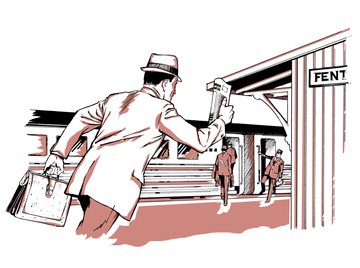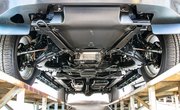
Typically, large commercial trucks and trains use air horns. Air horns produce a noticeably loud warning sound, designed specifically for alerting nearby people or vehicles that the truck or train is close. Often, the horn sounds as a warning that an obstacle may be struck unless attention is paid to the large, moving vehicle. Typically, trains use the loudest air horns, which can be measured in decibels.
Air Horn Features
An air tank supplies air pressure to an air horn. Inside the air horn, an end cap houses a metal diaphragm. The diaphragm vibrates with the supplied air pressure from the air tank. The vibration creates the air horn's unique sound. More air pressure, or volume, applied to the air horn generates larger sound-wave amplitudes. As a result, high decibels, or measured sound intensities, emit from the air horn.
Truck Vehicle Decibel Levels
A large commercial truck can produce air horn decibel levels of approximately 150 decibels. For comparison, a power lawn mower only generates 100 decibels of sound. Typically, vehicle air horns don't reach higher than this decibel level for the hearing safety of the surrounding public. Personal vehicles can also have aftermarket air horns installed, but users must use the horns with care, especially in residential areas.
Train Decibel Levels
Trains use the loudest air-horn decibels at 175 decibels. Trains require an extremely loud horn for notifying any person in the surrounding area that the locomotive is approaching. However, trains need a lot of space for braking in an emergency. The loud decibels emitted can possibly stop a collision further down the train tracks. The horn notifies the person or obstruction of the impeding train passing, well before the locomotive enters the immediate area. The train may not be able to stop quickly enough for an obstruction close to the train's leading car.
Alternative Vehicle Installation
An air horn, typically used for a large truck, can also be installed on a boat. The sound travels far across the water, warning incoming boaters that there's another boat in the vicinity. This loud warning sound may prevent boating collisions, especially in poor visibility conditions, such as fog.
Considerations
Installing an air horn on a personal vehicle requires consideration before purchasing the kit. According to the National Institutes of Health, hearing loss can easily begin at just 85 decibels of sound exposure. Because air horns generate decibel levels much higher than 85, consumers must consider when the horn should be used if it's installed. Air horns shouldn't be sounded in residential areas: They should be used mainly on open highways. A person close to the blasting air horn may immediately experience partial or complete hearing loss
About the Author
Writing professionally since 2010, Amy Rodriguez cultivates successful cacti, succulents, bulbs, carnivorous plants and orchids at home. With an electronics degree and more than 10 years of experience, she applies her love of gadgets to the gardening world as she continues her education through college classes and gardening activities.
Photo Credits
Creatas/Creatas/Getty Images
